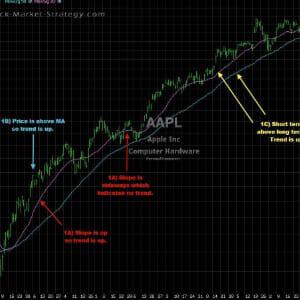Any trader who has been trend trading has heard the saying: A trend is your friend till it ends! It's catchy and makes completely sense but the problem is when does the trend end?
A trend trader's biggest challenge is to determine when the trader should no longer buy the pullback or short the retracement. The trend trader often tries to "guess" which pullback/retracement not to trade in order to increase their hit-rate and thereby increase their profit. The problem is that if the trader does not use fixed rules to determine which pullbacks/retracements to trade they will not be able to run stats on the results and thereby not be able to see if the trader makes more or less money by being selective. If the selection process is based on "feelings" it is impossible to run a back-test.
How to determine whether a trend is more likely to continue than to reverse.
The rules are there to force the trader to stay disciplined. The rules are set out so 1.certain criteria has to be met and 2. to allow you to back test if those rules are profitable. This means that if the system has made money for example in one year, it is highly likely to make money in the future. If a trader just uses a "feeling" to determine which pullbacks/retracements they should trade it is then impossible to say whether the trader will be consistently profitable. The rules are objective while the feelings are subjective.
Many traders, including ourselves, have been in the situation about whether or not to take the trade. This is something we often need to decide relatively fast when daytrading. We therefore started looking at historical charts in order to see if we could set up some fixed rules to guide us. Note that these rules are not the Holy Grail! Trading is not about being right 100% of time but about making more money than losing by increasing the odds. These rules do just that:
- The slope of the moving average (MA)
- How many pullbacks/retracements have there been in the trend
- Decreasing or increasing volume on the pullbacks/retracements
- Price has to respect prior swing high in an uptrend or respect prior swing low in a down trend.
- Price has not taken out any prior high/low.
When the slope of the moving average (MA) is very steep it shows that price has moved in a strong trending manner. When that has happened, stats shows that the trend is more likely to continue until the slope of the MA starts to flatten out or at least less steep.
If the trend is in alignment with the higher timeframes and if the retracement/pullback is the first or second time, only then do the odds favors trend continuation. The third setup has a lower hit-rate. The longer we are in the trend the smaller position we enter with.
During the pullback/retracement it is important to look at volume to determine if there is a shift in the market/stock. Decreasing volume in a pullback signals profit taking, instead of fresh selling. This means that the stock just needs to shake the weak longs before climbing further, thereby staying in an uptrend.
In an uptrend, We prefer price to climb in stair steps. This means price pulls back to a maximum to prior swing high for it then to continue up. When price can manage to climb like that it signals strength and thereby trend continuation.
This last rule can be confusing as many traders would say that if a prior high/low is taken out then the trend is broken and trade should not be initiated. But there are some traders who believe that if MA is still up sloping or if major trend line is still intact then trend is ok. They are more open to entering what they believe is a pullback but really is a trend reversal. My rules, for example, say that in an uptrend no swing low is allowed to be taken out. This allows me to trade only the really strong trends.
Our Implementation
We follow these rules in our trading strategies on all time frames. 3 min, 60 min and daily charts. No exceptions! If we don't feel comfortable about the trend we will pass on the trade. There is always tomorrow. A new day, a new trade!
